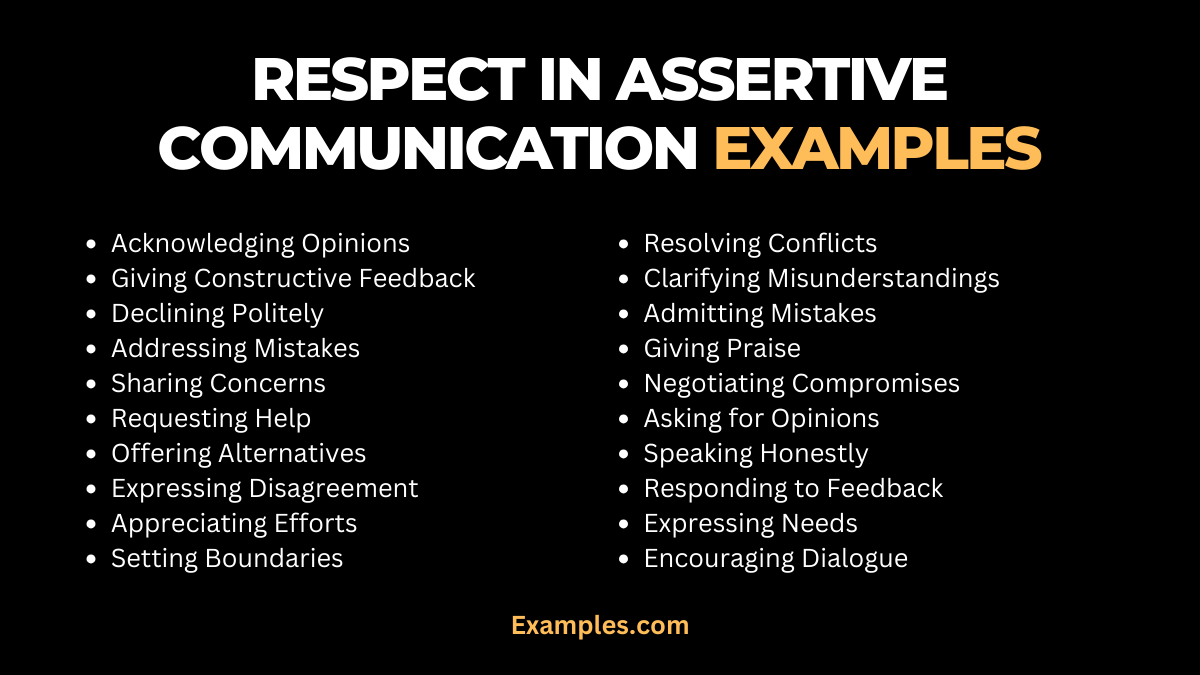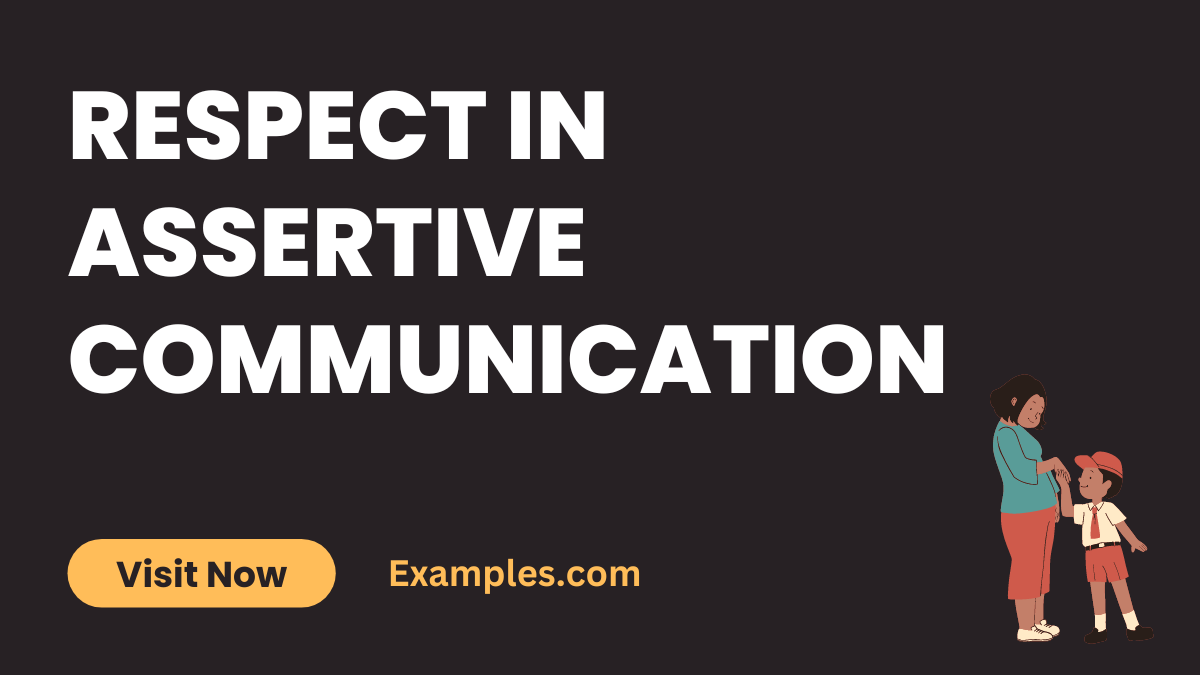19+ Respect in Assertive Communication Examples
Respect in assertive communication is crucial for building healthy, balanced relationships. This comprehensive guide delves into various communication examples that epitomize respect in assertive interactions. From professional settings to personal conversations, understanding how to convey respect assertively enhances both the clarity and effectiveness of your communication. We’ll explore key principles and practical examples that demonstrate how to integrate respect seamlessly into your assertive communication style.
What is Respect in Assertive Communication?

Respect in assertive communication refers to the art of expressing oneself honestly and directly while simultaneously honoring the feelings and rights of others. It involves a balanced approach where one stands up for their own needs and opinions without disregarding or diminishing the other person’s perspective. This definition underscores the importance of mutual understanding and esteem in interactions, essential for building trust and cooperation in any relationship.
20 Respect in Assertive Communication

Respect in assertive communication is a delicate balance of expressing oneself clearly and listening actively, all while valuing others’ perspectives. This approach fosters an environment of mutual understanding and trust. Here, we present 20 unique and distinct examples, each illustrating how to effectively combine respect with assertiveness in various scenarios.
1. Acknowledging Opinions:
This response respects the other’s opinion while assertively presenting your own.
Example: “I understand your viewpoint, but I have a different perspective.”
2. Giving Constructive Feedback:
This balances positive reinforcement with actionable suggestions.
Example: “Your report was well-researched. I suggest adding more case studies for depth.”
3. Declining Politely:
Politely declining shows respect for the offer while asserting your boundaries.
Example: “I appreciate the offer, but I must decline due to prior commitments.”
4. Addressing Mistakes:
This approach addresses issues without assigning blame.
Example: “I noticed an error in our calculation. Let’s review it together.”
This approach addresses issues without assigning blame.
5. Sharing Concerns:
Expressing concerns respectfully invites collaborative problem-solving.
Example: “I feel concerned about the project’s timeline. Can we discuss potential solutions?”
6. Requesting Help:
Asking for help while acknowledging the other’s skills is respectful.
Example: “Could you assist me with this task? Your expertise would be valuable.”

7. Offering Alternatives:
This shows willingness to consider other perspectives.
Example: “While I disagree, I’m open to exploring your suggestions further.”
8. Expressing Disagreement:
Assertively stating disagreement while remaining open to dialogue.
Example: “I see things differently and would like to explain why.”
9. Appreciating Efforts:
Gratitude expresses respect for others’ contributions.
Example: “Thank you for your hard work; it really made a difference.”
10. Setting Boundaries:
Clearly stating boundaries shows respect for both parties’ time.
Example: “I value our discussions, but I need to focus on this task right now.”
11. Resolving Conflicts:
This invites cooperative conflict resolution.
Example: “Let’s find a solution that works for both of us.”
12. Clarifying Misunderstandings:
Proactively addressing potential misunderstandings demonstrates respect.
Example: “I want to clarify my earlier statement to avoid any confusion.”
13. Admitting Mistakes:
Admitting mistakes honestly is a key aspect of respectful communication.
Example: “I realize I was wrong in my assumption. Let’s correct it.”
14. Giving Praise:
Praising genuinely shows appreciation for others’ efforts.
Example: “Your presentation was excellent and very informative.”
15. Negotiating Compromises:
Negotiating respectfully considers all parties’ interests.
Example: “I understand your needs. Can we find a middle ground?”
16. Asking for Opinions:
Seeking others’ opinions values their input and expertise.
Example: “What are your thoughts on this approach?”
17. Speaking Honestly:
Honesty, when expressed respectfully, enhances communication.
Example: “Honestly, I believe there is a better solution to this problem.”

18. Responding to Feedback:
Respectfully acknowledging feedback shows openness to improvement.
Example: “Thank you for your feedback. I’ll take it into consideration.”
19. Expressing Needs:
Clearly stating personal needs in a respectful manner.
Example: “I need some time to think this over. Let’s reconvene later.”
20. Encouraging Dialogue:
Encouraging ongoing dialogue demonstrates respect for others’ perspectives.
Example: “Your insights are valuable. Let’s continue this conversation.”
How to be Respectable in Assertive Communication?
- Active Listening: Show genuine interest in others’ opinions. This demonstrates respect and encourages open dialogue.
- Clear Language: Use simple, direct language to convey your thoughts without ambiguity, showing respect for the listener’s understanding.
- Positive Body Language: Maintain eye contact and open posture to show engagement and respect for the conversation.
- Acknowledging Others’ Perspectives: Recognize and validate different viewpoints, even if you don’t agree with them.
- Emotional Intelligence: Be aware of and control your emotions, ensuring respectful and constructive interactions.
- Consistent Respect: Treat everyone with respect, regardless of their position or relationship to you.
- Solution-Focused Approach: Focus on finding mutually beneficial solutions rather than winning an argument.
- Honesty with Tact: Be truthful in your communication, but also considerate of others’ feelings.
- Personal Accountability: Take responsibility for your actions and words, fostering a respectful environment.
- Respectful Disagreement: Learn to disagree without being disagreeable, maintaining a tone of respect even in conflict.
Components of Respect in Assertive Communication?
- Understanding: Grasping the other person’s viewpoint is key to respectful assertive communication.
- Empathy: Putting yourself in others’ shoes helps communicate with sensitivity and respect.
- Clarity: Being clear and concise in your communication prevents misunderstandings and shows respect for others’ time and effort.
- Patience: Allowing others the time to express themselves without interruption conveys respect.
- Non-verbal Cues: Your body language should align with your words, showing attentiveness and respect.
- Assertiveness: Stand firm on your views while respecting others, balancing self-expression with consideration.
- Feedback: Offer constructive feedback that respects the recipient’s feelings and encourages growth.
- Respect for Boundaries: Recognize and respect personal and professional boundaries in communication.
- Consistency: Be consistently respectful in all interactions, establishing trust and credibility.
- Listening to Feedback: Show respect by being open to receiving and acting on feedback from others.
Respect in assertive communication is essential for healthy interactions. This article has offered insights and examples on how to blend respect with assertiveness. Remember, respecting others’ views while expressing your own is the hallmark of effective communication.



